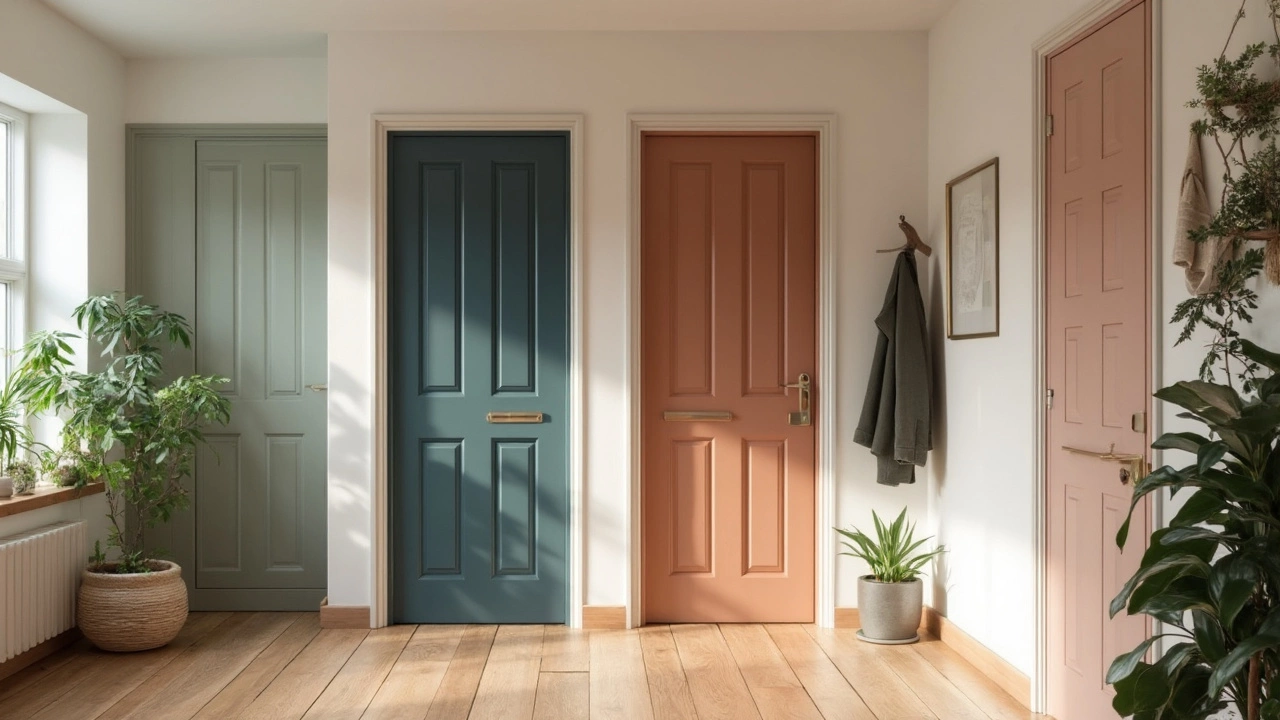White doors used to be the safe bet. But right now, everyone seems tired of playing it safe. Seriously, have you noticed friends showing off darker doors or even bright blue ones on social media? There’s a reason for that—they've realized that a new door color can totally change how a room feels.
Choosing the right color isn’t just about style—it can make your hallway feel brighter, highlight cool artwork, or even hide fingerprints (we all know how fast those show up if you have kids around). Door color has become an easy upgrade that instantly makes your home feel more modern and interesting, without gutting everything or spending a fortune. Not sure where to start? You’re in the right place.
- Why Door Color Matters Now
- Trending Door Colors in 2024
- Matching Door Colors With Your Decor
- Tips for the Perfect Finish
Why Door Color Matters Now
Back in the day, interior doors were mostly white because it was easy, cheap, and pretty much matched everything. But homes have changed a lot. Now, with open floor plans and everyone fighting for a little personality in their space, interior door colors play a bigger role than ever.
The door isn’t just a barrier; it's part of your house’s style. By switching up door colors, people are finding ways to tie rooms together, add contrast, or just show off their style without major renovations. Designers say that the color you pick for your door can boost a room’s mood, make a hallway feel longer, or even visually raise a low ceiling.
This isn’t just opinion either. According to Houzz’s 2023 home trends survey, 38% of homeowners who updated their interior doors in the past year picked something other than white or wood tones. The most common reason? “Wanted a fresh, modern look,” followed by “liked seeing colored doors on design shows and social feeds.”
There’s a practical side, too. Darker interior door colors not only look striking, but they’re awesome for hiding scuffs and smudges. If you’re dealing with pets or kids, going with a deep blue or charcoal can save you a lot of cleanup frustration.
- Door color sets the tone for a room—think cozy, energetic, or modern.
- Non-white doors make art, trim, or wall color pop way more.
- They're an easy project you can literally finish in a weekend.
So, if you’re ready to get more out of your modern home, reconsider that door color. It’s not just a detail—it changes the whole feel of your space.
Trending Door Colors in 2024
If you’re scanning Instagram or design blogs, you’ll spot a wild mix of interior door colors in 2024—people aren’t just sticking to basic neutrals anymore. The big names like Benjamin Moore and Behr say we’re in a “colorful rebellion,” with more folks painting doors for personality, not just to match the trim.
Black doors have surged in popularity again. They make any hallway or bedroom pop because they add contrast without being loud. Surprisingly, they don’t show fingerprints as much as you’d expect and are awesome for a modern vibe. If you want something more chill but still trendy, deep green is leading the way. Shades like earthy olive and forest green are everywhere—they go with natural wood, white walls, and even colorful art. People say they make rooms feel calm and grounded.
Muted blues and soft grays are another top pick. They look sleek in modern homes and are easier to work into existing color palettes than you might think. Some homeowners are even brave enough to try navy, which gives that classic-yet-contemporary feel.
Another trend gathering steam: doors painted the same shade as the wall. Designers say this creates a seamless, high-end look. Rachel Cannon of Cannon & Company recently said,
“Color-drenching doors and trim, especially in earthy tones, is making spaces look curated and fresh. It’s a trick anyone can use.”
If you’re after something really bold, some designers are pushing rich rust, mustard, and even teal. These colors are all about expressing character—nothing bland about them. The idea is to treat your door like an accent piece, not just a backdrop.
| Color | Style Impact | Popular With |
|---|---|---|
| Black | Modern, clean contrast | Urban homes, apartments |
| Deep Green | Earthy, calming | Nature-inspired decor fans |
| Navy | Classic-meets-trendy | All-white or neutral interiors |
| Muted Blue | Soft, versatile | Family homes, new builds |
| Color-Drenched (matching wall) | Seamless, high-end | Minimalists, trendy homeowners |
| Rust/Mustard/Teal | Bold and expressive | Modernists, young creatives |
Of course, the best door color is one that works for your space and feels like you. The cool thing? In 2024, there’s really no single right answer. It’s about finding what you love—and not being afraid to show it off.

Matching Door Colors With Your Decor
Picking the right interior door colors isn’t rocket science, but it does call for a little planning if you want things to look intentional. You don’t want your doors to stand out in a bad way or totally clash with your walls or furniture. The goal is to tie everything together—or go bold on purpose. Here’s how people are nailing it in 2024.
First, look at your color palette. If your home is filled with cool tones (like blues, greens, or grays), a door in a soft sage green or even a charcoal can work perfectly. On the other hand, if you’re rocking warm tones (think beiges, terracottas, or oranges), deep browns or a warm olive tone fit right in.
Don’t overlook contrast. A popular move right now is pairing light walls with dark doors—think crisp white walls with sleek black or navy doors. This combo instantly feels modern and sharp. Flipping it around works, too: darker walls with a lighter door bring energy without feeling overwhelming.
Here’s a quick way to think about matching door colors with your decor:
- Match: Choose a door color a few shades lighter or darker than your wall—this gives depth without switching up the vibe too much.
- Contrast: Go way lighter or darker with your door color to make it pop against the walls, especially useful in halls or shared spaces.
- Accent: Use the door as a chance to add a fun accent color found in your throw pillows, art, or rugs. This is huge in kids’ rooms and home offices right now.
Material matters, too. Got natural wood floors or beams? Doors that let the wood grain show (like stains in walnut or oak) blend seamlessly in spaces going for that cozy-yet-modern style, which has been all over design magazines this year.
Need a decision shortcut? Let the amount of natural light guide you. A darker door color looks crisp in a sunny space, but can feel heavy in a darker hallway. If the area doesn’t get much light, lighter doors keep things from feeling closed in.
Want to know what other people are going for? Check out the table below using data from a 2024 Houzz survey about interior door colors that homeowners have chosen to match their existing decor:
| Wall Color | Popular Door Color Choices | % of Homeowners |
|---|---|---|
| White/Gray | Navy, Black, Warm Wood | 42% |
| Blue/Green | Charcoal, Light Oak, Sage | 28% |
| Beige/Taupe | Dark Brown, Olive, Cream | 21% |
| Other/Bold | Contrasting Brights (Yellow, Red) | 9% |
Even if you’re not following trends to the letter, thinking about how interior door colors sync up with your overall style just keeps things looking fresh—not random.
Tips for the Perfect Finish
Nailing the final look on your interior door colors is way easier if you keep a few things in mind. Chipping paint or streaks can ruin the vibe, no matter how trendy your color is. Let’s break down what actually works and keeps your doors looking pro-level for longer than a few months.
- Prep matters most. Don’t skip cleaning the surface. A damp cloth will handle most fingerprints and dust. If your door’s got old, flaking paint, hit it with a bit of light sanding so the new color sticks well. Most pros swear by using a primer—especially if you’re switching from a dark to a light shade or vice versa.
- Pick the right finish. Eggshell and satin finishes are way more forgiving than high-gloss. They hide bumps, resist fingerprints, and are easy to wipe down. Flat finish is rarely a good idea for doors in busy spaces, since it marks up pretty quickly.
- Quality paint saves headaches. If you’re using one of 2024’s bold modern home shades, go for high-quality paint designed for trim and doors. Cheap paint needs extra coats and chips faster.
- Right tools make life easier. A small foam roller works wonders for flat surfaces. For panels or edges, grab a tapered brush—look for 2-inch or 2.5-inch angled versions.
- Take off the hardware. If you want a crisp look, pop off the handles and use painter’s tape on hinges. Don’t trust steady hands alone—paint sneaking under handles or onto hinges just looks sloppy.
The team at This Old House puts it simply:
“You only get that smooth, streak-free finish if you work clean, use the right products, and let each coat dry fully before adding another.”
Speaking of dry time, don’t cut corners. Water-based paints are usually ready for a second coat after about two hours, while oil-based paints need longer—sometimes up to eight hours.
Here’s a quick look at common paint types and their drying times, so you’re not guessing:
| Paint Type | Dry Time (Touch) | Dry Time (Recoat) |
|---|---|---|
| Water-Based (Acrylic/Latex) | 1 hour | 2-4 hours |
| Oil-Based | 6-8 hours | 8-24 hours |
Stick with these tips and you’ll have that sharp, durable finish people keep noticing. If in doubt, test your paint ideas on a small spot to see how the color works with your light, furniture, and vibe. Once you see it, you’ll know if you picked a winner.
